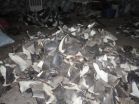(Press-News.org) MEDFORD/SOMERVILLE, Mass. – Colonoscopy is regarded as the most thorough way to screen for colon cancer but the potentially life-saving procedure can also be painful. Scientists and engineers are continually researching new methods of screening to reduce patient discomfort while also ensuring the accuracy of the exam. Researchers at Tufts University's School of Engineering led by Associate Professor of Mechanical Engineering Caroline G.L. Cao, Ph.D., have developed a device that could potentially do both.
Tufts endoscopic fiber optic shape tracker (EFOST) technology is a possible solution to the problem that occurs when the endoscope is inserted into the colon during routine screening. As an endoscopist navigates the scope through the bends and turns in the colon, its tip can impinge against the colon wall.
When this happens, the tip becomes stationary and is unable to move forward. As the physician applies more pressure, a loop can form in the length of scope behind the tip. Because the traditional endoscope provides only a frontal view during the procedure, the doctor cannot see the loop, much less easily maneuver the scope to remove it. Not surprisingly, looping can be a major source of pain during a colonoscopy.
But by outfitting an endoscope with fiber optic bend sensors and digital electronics that display its position and shape on a video monitor, the Tufts engineers have built a system that could serve as a visual navigation tool, says Cao
"Doctors will have a way to see in real-time how the scope is moving inside the patient's body," says Cao. "If the scope begins to loop, they will see it instantaneously and then be able to make adjustments to straighten it out."
Bend Sensors to Create a Visual Image
Cao and Mechanical Engineering Research Associate Professor Peter Y. Wong, Ph.D, described their concept in a paper titled "Localized Active-Cladding Optical Fiber Bend Sensor" in June 2010 in the journal Optical Engineering.
Using a prototype, the Tufts engineers embedded quantum dots -- nano-sized crystals of semiconductor material -- circumferentially at intervals along the length of an optical fiber. The researchers stretched the fiber around a metal cylinder to create a bending effect. They then injected a laser light beam into the fiber's inner core from one end.
The fiber's core released light as it is bent. This activated the quantum dots. Instantly, the dots reemitted light signals of varying intensity to a spectrometer. With this data, the researchers were able to measure the degree of curvature in the fiber. From the position of the activated dots, the researchers were also able to calculate the direction of the bend. "The greater the bend, the more intense the light emissions," says Cao.
In a separate experiment, the team used an inanimate model colon made of polyurethane foam.. They inserted the modified fiber inside an endoscope and then threaded the device into the model. The researchers were able to produce a video image by sending the data through a digital processor which created a real-time image of the scope in the model colon.
Cao notes, "Physicians can use the image on the monitor to guide them. They'll know exactly where the end of the point is, as well as the shape of the scope inside the colon."
Colorectal cancer is the third leading cause of cancer-related deaths in the United States, with 102,900 new cases diagnosed in 2010, according to most recent estimates from the American Cancer Society.
Colon cancer has a high cure rate provided it is detected early. Most men and women are advised to undergo periodic colonoscopies beginning at age 50.
The commercialization of EFOST is being managed by Tufts University's Office for Technology Licensing and Industrial Collaboration. There are currently patents s pending in the USA, Canada, Europe, Japan and Australia. The next step, Cao says, is to acquire funding to launch a start-up company and then move on to further development of the technology, including eventual clinical trials.
###
This work was supported by a Broad Medical Research Grant from the Eli and Edythe L. Broad Foundation. The pending patents are jointly owned by Tufts University, University of Toronto and University Health Network Toronto.
Tufts University, located on three Massachusetts campuses in Boston, Medford/Somerville and Grafton, and in Talloires, France, is recognized among the premier research universities in the United States. Tufts enjoys a global reputation for academic excellence and for the preparation of students as leaders in a wide range of professions. A growing number of innovative teaching and research initiatives span all Tufts campuses, and collaboration among the faculty and students in the undergraduate, graduate and professional programs across the university's schools is widely encouraged.
Tufts University School of Engineering is dedicated to educating the technological leaders of tomorrow. Located on Tufts' Medford/Somerville campus, the School of Engineering offers a rigorous engineering education in an environment characterized by the best blending of a liberal arts college atmosphere with the intellectual and technological resources of a world-class research university. Close collaboration with the School of Arts and Sciences and the university's extraordinary collection of excellent professional schools creates a wealth of educational and research opportunities. The School of Engineering's primary goal is to educate engineers committed to the innovative and ethical application of technology in the solution of societal problems. It also seeks to be a leader among peer institutions in targeted areas of interdisciplinary research and education that impact the well-being and sustainability of society, including bioengineering, sustainability and innovation in engineering education.
END
STONY BROOK, NY, April 27, 2011–An international team of scientists, led by the Institute for Ocean Conservation Science at Stony Brook University, has used DNA to determine that groups of dusky sharks (Carcharhinus obscurus) and copper sharks (Carcharhinus brachyurus) living in different coastal regions across the globe are separate populations of each species. Both are large apex predators that are heavily exploited for the shark fin trade, which claims tens of millions of animals every year to produce the Asian delicacy, shark fin soup. Many of these species are declining ...
Fruit flies that moved from sub-Saharan Africa found themselves confronted by conditions very different from those to which they were accustomed. Most obviously, the average temperatures were considerably lower and so it is no surprise that the flies had to adapt to cope with life in the north. As a result of thousands of years of evolution, populations in sub-Saharan African and in Europe now differ dramatically in a number of characteristics known to relate to temperature (such as pigmentation, size and resistance to cold). Schlötterer's previous work had suggested ...
When you are plagued by unsightly facial lines and wrinkles, nothing can be more satisfying than immediate correction with dermal fillers. Dermal fillers consist of biocompatible materials, such as concentrated hyaluronic acid, that are injected beneath the skin to enhance subtle contours and soften facial creases and wrinkles brought on by old age. If you would like to regain your youthful appearance without the downtime required for facelift surgery, dermal fillers may be right for you.
How to Select a Dermal Filler For Your Needs
There are dozens of dermal fillers ...
A study by the Spanish Foundation for Science and Technology (FECYT) shows a lack of standardisation in the peer review systems whereby independent experts assess the content of scientific publications published in Spain. This results in a low level of international competitiveness among these publications.
"We studied the entire peer review process, beyond the fact of such a review simply being stated in the publication. Our research showed a low level of standardisation in these processes. This reflects a need to work to professionalise some of the Spanish scientific ...
Government Shutdowns, Budget Deficits and Social Security Benefits
With a government shutdown recently narrowly averted, many people wondered what happens to Social Security benefits during a government shutdown. While the Social Security Administration is able to operate on its own during a shutdown, shortcomings in the SSA's funding as well as issues with the federal deficit and debt ceiling may signal trouble for the SSA and people receiving Social Security benefits in the future.
Government Shutdown
During a government shutdown, only "essential" ...
In urban communities, less than 1 in 100 inhabitants died from Spanish flu in 1918, but in isolated communities up to 9 out of 10 died. An important explanation for the differences is due to different exposure to influenza in the decades before the Spanish flu came. Those living in urban communities probably had a higher degree of pre-existing immunity that protected against illness and death in 1918 than those living in very isolated rural areas. This is shown in a new study from the Norwegian Institute of Public Health.
Previous studies have suggested that an important ...
The analysis assesses the 12-month prevalence of coronary heart disease (CHD) in individuals according to their category of alcohol use. The 2001 National Epidemiologic Survey on Alcohol and Related Conditions study (the NESARC study, n = 43,093) identified 16,147 abstinent individuals, 15,884 moderate consumers, 9,578 hazardous drinkers — defined as exceeding sex-specific weekly limits established by the World Health Organization, and 1,484 alcohol-dependent subjects. Diagnoses were generated using the Alcohol Use Disorder and Associated Disabilities Interview Schedule-DSM-IV ...
Car Accident Reports Impacted by Latest Ohio Transportation Budget
One important bit of wisdom that most people understand about the aftermath of an Ohio auto accident is to wait for police to arrive so you can provide your take on events for the police report. The information that law enforcement includes regarding a car crash or trucking accident is important for both criminal charges and civil liability. But the latest transportation and public safety budget passed by the Ohio General Assembly and signed by Governor Kasich limits the circumstances under which police ...
A new test shows promise for detecting the early stages of a major cause of failure in joint replacement implants, so that patients can be treated and perhaps avoid additional surgery. More than 1.5 million total joint replacement operations are performed worldwide each year. While the success rate is 90 per cent, almost 10 per cent of implants fail and require additional surgery, report appears in the ACS journal Molecular Pharmaceutics.
Dong Wang and colleagues at University of Nebraska Medical Center and the Hospital for Special Surgery of New York explain that wear ...
The first analysis of the healthful antioxidant content of blueberries that grow wild in Mexico, Central and South America concludes that some of these fruits have even more healthful antioxidants than the blueberries — already renowned as "super fruits" — sold throughout the United States. These extreme super fruits could provide even more protection against heart disease, cancer and other conditions, the report suggests. It appears in ACS' Journal of Agricultural and Food Chemistry.
Edward Kennelly and colleagues note that although there are over 600 species of blueberries ...

